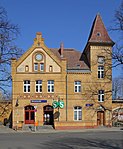Berlin-Schönholz station
Berlin S-Bahn stationsBuildings and structures in ReinickendorfRailway stations in BerlinRailway stations in Germany opened in 1877

Berlin-Schönholz railway station (German: Bahnhof Berlin-Schönholz) is a railway station in Berlin, Germany. It is located on the Berlin Northern Railway (Berliner Nordbahn) line in the district of Reinickendorf, though it is named after the adjacent Schönholz quarter of the neighbouring Pankow district. From here, the Kremmen Railway branch line leads to Hennigsdorf and Kremmen. The station is served by S-Bahn trains and local bus lines, and is protected as a listed monument.
Excerpt from the Wikipedia article Berlin-Schönholz station (License: CC BY-SA 3.0, Authors, Images).Berlin-Schönholz station
Schützenstraße, Berlin Niederschönhausen
Geographical coordinates (GPS) Address Nearby Places Show on map
Geographical coordinates (GPS)
| Latitude | Longitude |
|---|---|
| N 52.5714 ° | E 13.3811 ° |
Address
S Schönholz
Schützenstraße
13158 Berlin, Niederschönhausen
Germany
Open on Google Maps










